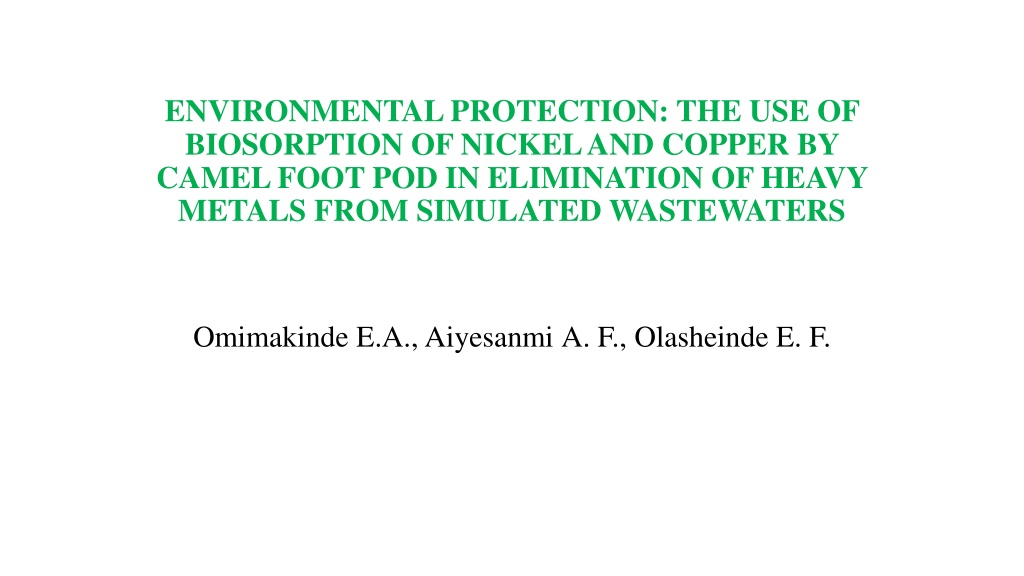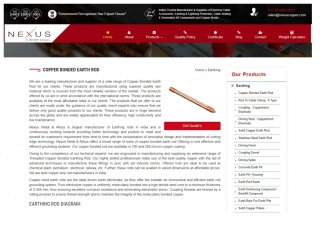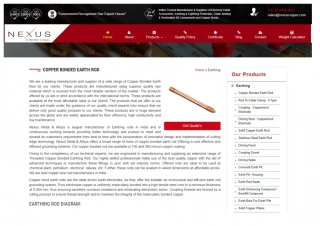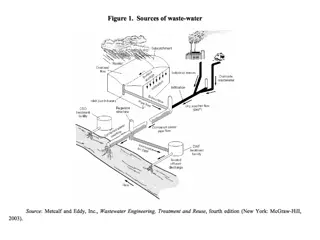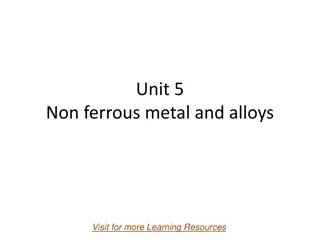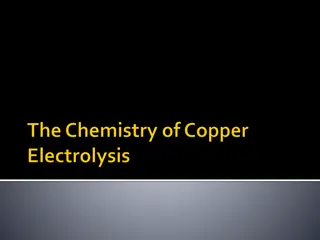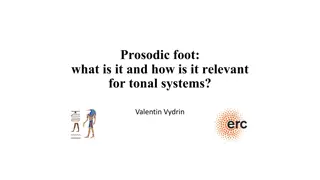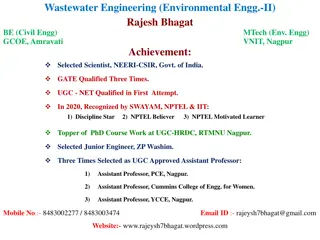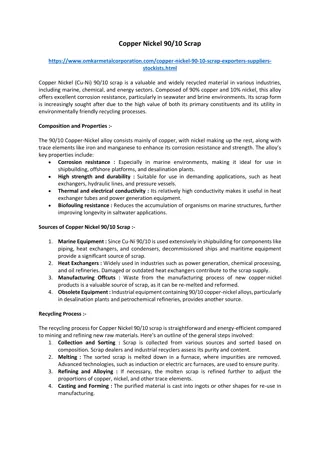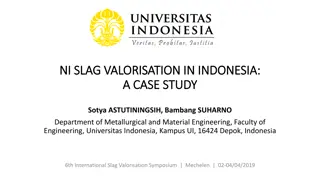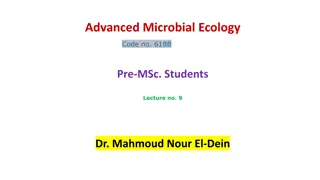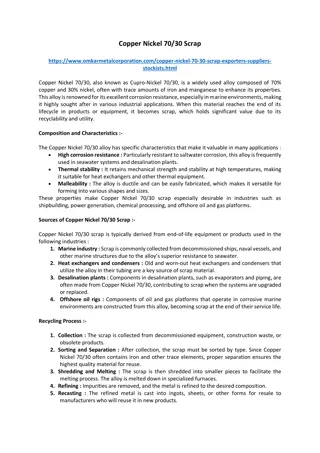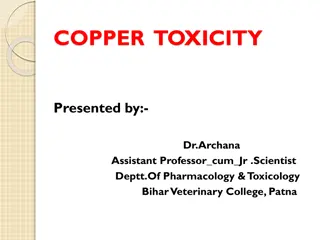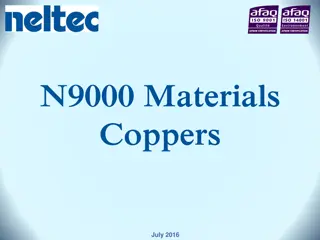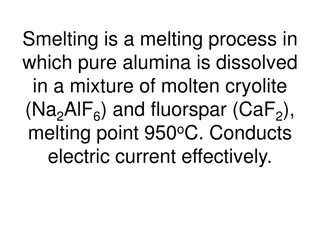Biosorption of Nickel and Copper by Camel Foot Pod for Heavy Metal Removal in Wastewater
Sustainable development efforts emphasize environmental protection, including water pollution control. This study explores the biosorption of nickel and copper using camel foot pods to remove heavy metals from simulated wastewaters. The introduction highlights the significance of addressing high heavy metal concentrations in water pollution. Methodology involves preparing adsorbents from camel foot pods sourced from a university premises. Results and discussion focus on the efficiency of biosorption. Finally, policy recommendations underscore the importance of adopting eco-friendly solutions for water treatment.
Download Presentation

Please find below an Image/Link to download the presentation.
The content on the website is provided AS IS for your information and personal use only. It may not be sold, licensed, or shared on other websites without obtaining consent from the author. Download presentation by click this link. If you encounter any issues during the download, it is possible that the publisher has removed the file from their server.
E N D
Presentation Transcript
ENVIRONMENTAL PROTECTION: THE USE OF BIOSORPTION OF NICKEL AND COPPER BY CAMEL FOOT POD IN ELIMINATION OF HEAVY METALS FROM SIMULATED WASTEWATERS Omimakinde E.A., Aiyesanmi A. F., Olasheinde E. F.
OUTLINE Introduction Methodology Results and Discussion Summary and Policy Recommendation References
INTRODUCTION Sustainable development is the hope for the future economies. All efforts to promote the three pillars of sustainable development such as economic, social and educational efforts as well as environmental protection should be embraced. The sixth Sustainable Development Goal which emphasizes clean water and sanitation for all cannot be achieved if the problem of water pollution lack proper attention it demands. High heavy metal concentration is a major culprit in the problem of water pollution
INTRODUCTION Heavy metals are chemical elements with a specific gravity of not less than five (5). Copper and nickel are classified as heavy metals and they are dangerous to health and the environment at high concentrations (Chiarelli and Roccheri, 2012). They are toxic, affecting, among others, the kidneys and liver, skin, bones, or teeth (Hussain et al., 2011). Although toxicity and the resulting threat to human health of any contaminant are, of course, a function of concentration, it is well-known that chronic exposure to heavy metals and metalloids at relatively low levels can cause adverse effects (Castro-Gonz lez and M ndez-Armenta, 2008). Therefore, there has been increasing concern, in the developed and developing world, about exposures, intakes and absorption of heavy metals by humans.
INTRODUCTION Water is polluted when it is impaired by anthropogenic pollutants and does not support a human use such as drinking, and undergoes a marked shift in its ability to support its basic biotic communities like fish. Natural phenomena such as volcanoes, algae blooms, storms, and earthquakes also cause major changes in water quality and the ecological status of water (NTP, 2000; Khatri & Tyagi, 2015 ).
METHODOLOGY: Adsorbents preparation The adsorbent used for this study was prepared from the camel s foot (Piliostigma thonningii) pods sourced within the premises of Federal University of Technology Akure, Ondo State. The pods were harvested from the top of the Piliostigma thonningii trees. The pods were opened, the seeds removed and the pods were washed with distilled water and oven dried between 95-105 0C for three days. The dried pods were ground to fine particles and sieved using 300 m, 850 m, 1.17 mm and 1.70 mm pore sizes (Adebayo et al., 2012). These were stored in air- tight containers and then used for subsequent batch sorption studies.
METHODOLOGY-Simulated water (SW) preparation 1,000 mg/L stock solution of copper ions (Cu2+) was prepared by dissolving 3.803 g of copper (II) trioxonitrate (v) trihydrate in distilled water of 1,000 cm3standard volumetric flask and made up with distilled water. 1,000 mg/L stock solution of nickel ions (Ni2+) was also prepared by dissolving 4.475 g of nickel tetraoxosulphate (vi) hexahydrate in distilled water in 1,000 cm3standard volumetric flask and made up with distilled water. Working concentrations used for the batch sorption studies were prepared by serial dilution from the stocks as required (Onundi et al., 2010).
METHODOLOGY:- pH study The pH study investigated the effect of pH, on the sorption of metal ions on the biomass, ten (100 cm3) samples in duplicate of 50 mg/L of each adsorbate were prepared. Their pH was adjusted to pH of 1 to 10 by adding drops of 0.1 M NaOH and 0.1 M HNO3. 1.0 g of the adsorbent (850 m in size) was weighed and added to each of the 100 cm3of the 50 mg/L metal solutions, stirred manually at intervals for 480 mins and then filtered (Anirudhan and Suchithra, 2010). The filtrates were stored in clean sample bottles and the residual metal ion concentration in each filtrate was determined using Perkin Elmer AAnalyst 400 atomic absorption spectrophotometers (AAS)
METHODOLOGY: Time/concentration study The following metal concentration of Ni2+and Cu2+ ions were prepared : 50 mg/L, 100 mg/L, 200 mg/L, 300 mg/L, and 500 mg/L and the pH was adjusted to the optimum pH of 4 for both nickel and copper ions. The Piliostigma thonningii pod (1.0 g) was added to each solution. The time interval was also varied for various metal concentrations (30, 60, 120, 180, 240, and 360 minutes). The solutions were stirred after which they were filtered at the end of each time interval (Anirudhan and Suchthra, 2010). The residual metal concentrations in the filtrate were determined using AAS
METHODOLOGY : Adsorbent Dosage Study Solutions of 50 mg/L concentration of each metal ions (Ni2+and Cu2+) were prepared. The pH of each 100 cm3portion in ten beakers were adjusted to the optimum pH of 4 and the following doses of the biomass (850 m) were introduced (0.50 g, 1.0 g, 1.5 g, 2.0 g, 2.5 g). Each mixture was thoroughly stirred manually for the optimum time of four hours and three hours for Ni2+and Cu2+respectively and filtrate were analysed using AAS (Mehdiza deh et al., 2014)
METHODOLOGY: Temperature study Temperature study used one gram of the biomass added to 100 cm3of 50 mg/L solution of Ni2+and Cu2+separately having adjusted the pH to the optimum pH. The mixture was equilibrated in a water bath adjusting the temperature to 30 0C, 40 0C, 50 0C and 60 0C in separate studies. The mixture was stirred and allowed to stay for the optimum time, filtered and the filtrate kept for AAS analysis.
METHODOLOGY: study particle size Solution (100 cm3) of 50 mg/L of each metal was measured into eight conical flasks. The pH of the SW was adjusted to the optimum pH and 1.0 g of the following biomass particle sizes (300 m, 850 m, 1.17 mm and 1.70 mm) was introduced into it. Each mixture was stirred at intervals for the optimum time at room temperature and was filtered after 3 and 4 hours for Ni and Cu. The residual concentration of Ni2+and Cu2+in each filtrate was determined in each portion The data obtained from AAS analysis were subjected to graphical analysis, intra-particle diffusion, pseudo first-order and second-order kinetic models.
RESULT AND DISSCUSION: Figure1 80 70 mean percentage adsorption(%) 60 50 Ni Cu 40 30 20 0 1 2 3 4 5 6 7 8 9 10 pH
RESULT AND DISSCUSION: pH study Effect of pH The plot of pH profile study for nickel and copper ions is presented in Figure 1. The plot showed an optimum binding at pH 4 for both nickel and copper ions. By increasing the pH from 1.0 to 4.0 the percentage ion adsorbed increased from 30% to 77.59% after which the adsorption decreased with increase in pH.
Result and Discussion The result (Figure 1) showed an optimum binding pH of 4. This agrees with what has been earlier reported by other researchers Enos et al. (2011) and Conrad et al. (2007). By increasing the pH from pH 1 to 2, the percentage nickel ion removal increased from 30% to 40.12%, while that of copper ion increased from 25.04% to 29.72%. The pH of the solution has a significant impact on the uptake of heavy metal ions. Adsorption increases as solution pH increases in acidic medium (Figueira, 2000; Kumar et al., 2014). The binding of Ni2+and Cu2+to the biomass is evidently dependent on the pH of the reaction medium. This had been confirmed earlier by Wang and Qin, 2005.
RESULT AND DISSCUSION: Effect of Contact Time At equilibrium, nickel ions had a maximum removal of 77%. Equilibrium was reached after 240 minutes after which no ion was further removed but rather there was a decrease in the rate of adsorption as reaction time increased. The adsorption of copper ions also followed the same trend as that of nickel ions but the maximum percentage removal (72.9%) was lower than that of nickel ions at equilibrium. The equilibrium time for copper ions was reached after 180 minutes, after which further increase in contact time did not show any increase in adsorption
Pseudo First Order Kinetics The Lagergren equation, a pseudo first-order equation, describes the kinetics of the adsorption process as follows: ??? ??= ?1(?? ??) (4.2) After definite integration by applying the initial conditions qt = 0 at t = 0 and qt = qt at t = t, equation (4.2) becomes (4.3) ?? ?? ?? = ?? ?? ?1?
A straight line graph of ln (?? ??) versus t suggests the applicability of this kinetic model to fit the experimental data. The graph (Figure 4.4) obtained in the current study suggests that the pseudo first- order kinetic model is not applicable to this study as can be seen from the non straight line graph of the kinetics proposing that the rate of adsorption does not depend only on the concentration of a single reactant but on the concentration of both the adsorbent and the adsorbates. Al-Anber and Al-Anber, (2008) also made the same observation while adsorbing iron (III) ions on olive cakes that the adsorption did not obey pseudo-first order reaction perfectly
Figure 4.4: Plot of pseudo-first order kinetics 1 0.5 0 0 50 100 150 200 250 300 350 400 -0.5 log (qe-qt) Ni -1 Cu -1.5 -2 -2.5 -3 Time(mins)
Second - Order Kinetic Model The linearized pseudo second-order kinetic model which is expressed as ? 1 2+ (4.4) 1?2.?? ??= ? ? 2 ( = initial metal adsorption rate) ? = ?2. ?? ? (4.5) This equation (4.4) was used to treat the adsorption data of the metal ions uptake by camel foot pod (Ho and Mckay, 2000) and it fitted well with this model
Figure 4.5: Plot of linearized second-order kinetics of Ni2+and Cu2+ 150 120 90 t/qt Ni 60 cu 30 0 5 60 115 170 225 280 335 390 Time (mins)
Effect of Temperature This study indicates that a lower temperature is more favourable for the adsorption of the ions on the biomass. Babarinde et al., (2012) reported a similar trend for the adsorption of nickel ion, chromium ion and cobalt ion from aqueous solutions using cocoyam (Colocasia esculenta) leaves. Mousavi et al., (2010a) and Nor et al., (2013) reported that the adsorption rate could decrease with increasing temperature, a trend which may be indicative of physical adsorption
Summary and Policy Recommendation Adsorption of nickel and copper ions from aqueous solutions using camel foot (Piliostigma thoninigii) biomass was investigated through batch process. The amount of copper and nickel ions uptake increased significantly with increase in pH range from 1 to 4 with the optimum pH being 4. Aqueous solutions of nickel and copper ions with starting concentrations of 50 mg/L gave the best percentage of adsorption by the biomass moreover adsorption capacity increased with increase in concentration of metal ions.
Summary and Policy Recommendation The time profile study showed that both the sorption of nickel and copper ions on camel foot biomass is characterized by a rapid initial adsorption step. 60% of the ions adsorbed were bound in the first 1 h of contact with the biomass. The optimum contact time for nickel ion adsorption was 4 h while that of copper ion was 3 h. The effect of adsorbent dosage on the adsorption process showed that the adsorption rate increased with increase in biomass dosage due to availability of more surface area for the adsorption.
Summary and Policy Recommendation The survey showed that camel foot biomass is an efficient, economical and inexpensive adsorbent for Ni2+and Cu2+ and can compete effectively with activated carbon. A policy should be put in place by the government to enforce the use of camel foot pod in the synthesis of composite adsorbent for the treatment of industrial effluents since these materials are cheap and readily available within the country
REFERENCES Adebayo J.O., Santana A.E.G. and Krettli A.U. (2012). Evaluation of the antiplasmodial and cytotoxicity potentials of husk fibre extracts from Cocos nucifera, a medicinal plant used in Nigeria to treat human malaria. Human and Experimental Toxicology, 31 (3): 244-249. A.J. and Balakrishnan V. (2010). Studies on the adsorption of ferrous ions from aqueous solution by low cost carbon. Journal of Chemical and Pharmaceutical Research, 2 (3): 733-745.
Aisien F.A., Amenaghawon A.N., and Adeboyejo A.R. (2013). Application of Recycled Rubber from Scrap Tire in the Removal of Phenol from Aqueous Solution . Pacific Journal of Science and Technology, 14 (2):330-341. Al-Anber Z. M. and Al-Anber M. A. S. (2008). Thermodynamics and Kinetic Studies of Iron (III) Adsorption by Olive Cake in a Batch System. Journal of the Mexican Chemical Society, 52: 108-115. Aljlil A.S. and Alsewailem F.D. (2014). Adsorption of Cu and Ni ions on Bentonite Clay from waste water. Athens Journal of Natural and Formal Sciences, 1(1): 21-30.
Anirudhan T.S. and Suchithra P.S. (2010). Equilibrium, kinetics and thermodynamics modeling for the adsorption of heavy metals onto chemically modified hydrotalcite. Indian Journal of Chemical Technology; 17: 247-249. Conrad K., Bruun and Hansen H.C. (2007). Sorption of zinc and lead on coir. Bioresource. Technology, 98: 89-97. Das B., Mondal N.K., Roy P. and Chatterji S. (2013). Equilibrium, kinetic and thermodynamic Study on chromium (VI) removal from aqueous solutions using Pistia stratiotes biomass. Chemical Science Trans, 2(1):85-104.
Denis A.T. (2000). Removal of copper and nickel from solution by the non- viable biomass of the water fern Azolla filiculoides in an upscaled fixed-bed column system. A M.Sc. Thesis submitted to the University of Rhodes, South Africa, 43-49.
